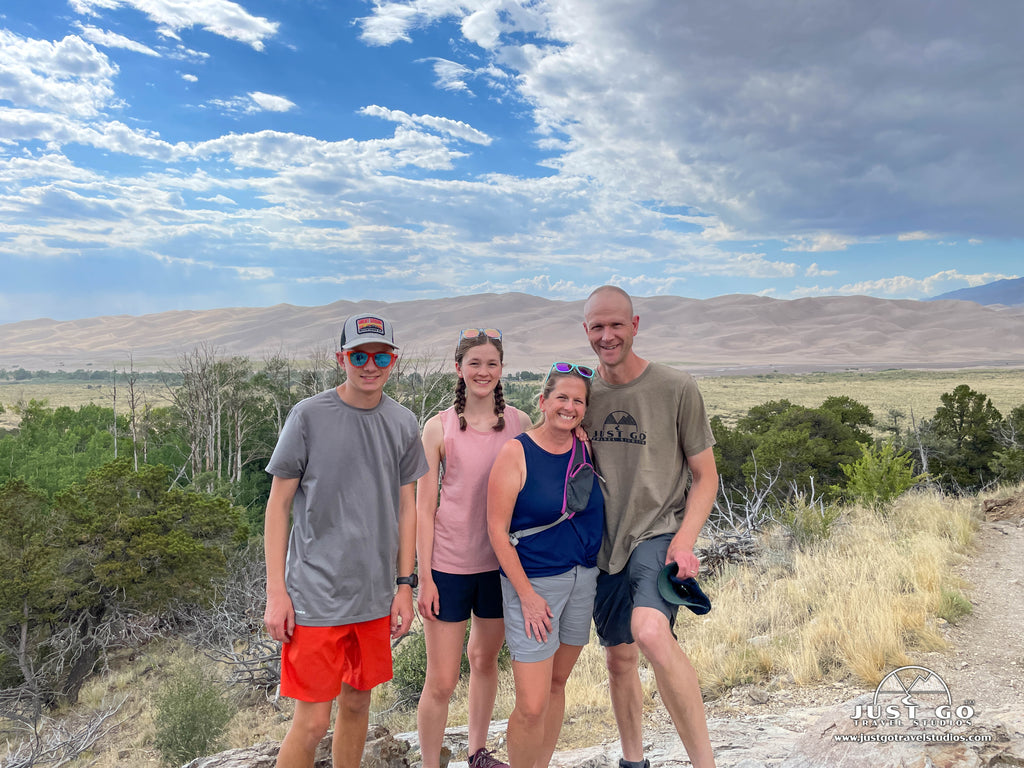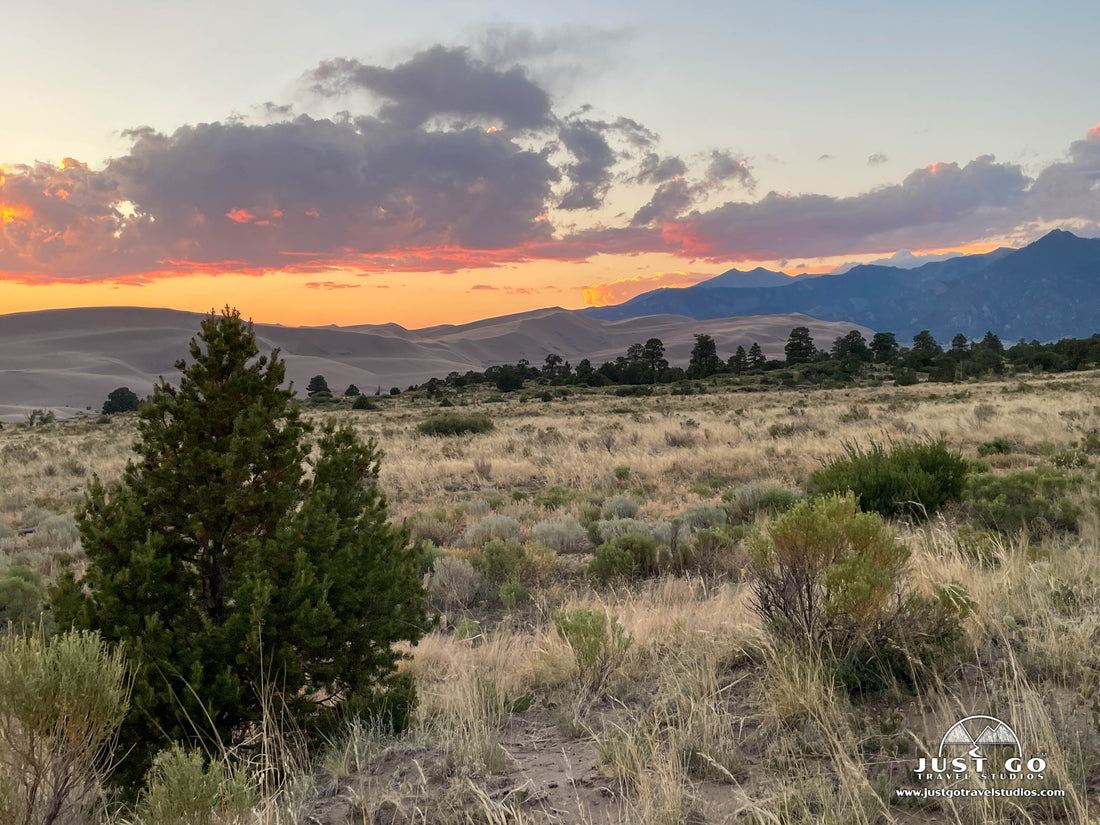
Great Sand Dunes National Park: Things to Do, Maps, Weather & More
Peter BrahanLocated in south-central Colorado, Great Sand Dunes National Park and Preserve protects almost 150,000 acres of pristine landscape. The park’s towering sand dunes are the main attraction—rising as high as 741 feet from floor of the San Luis Valley. However, alpine lakes, forests and wetlands are also vital parts of the complex dunes system at Great Sand Dunes National Park and Preserve.
Even before physically entering the park, visitors will be struck by the scenery—massive, golden sand dunes backed by the alpine peaks of the Sangre de Cristo range. With the variety of ecosystems that make up Great Sand Dunes National Park and Preserve, visitors will find unique opportunities for exploration and recreation. Whether you plan to sandboard, hike one of the tallest dunes in North America or experience the spectacular dark skies, Great Sand Dunes has something for everyone!
At a minimum, you’ll need a few hours to stop at the visitor center, take photos and hike out onto the dunes. However, if you enjoy hiking, sandboarding or exploring primitive roads in your 4WD vehicle, we recommend spending one to two days to fully explore this park. We hope this guide will help you plan an amazing trip to Great Sand Dunes!
Before you leave on your trip, be sure and get a copy of our itinerary for Great Sand Dunes National Park! We include what to do in 1, 2 or 3 days, the best day hikes, hiking maps and so much more!
GREAT SAND DUNES NATIONAL PARK & PRESERVE HISTORY
In the 1920s, the threat of gold mining in the dunes began to worry residents in the San Luis Valley. The local people, who used the dunes for their own recreational enjoyment, saw the importance of preserving the natural environment and the potential benefits of tourism for local businesses. In 1930, the women of the local chapter of P.E.O. (Philanthropic Educational Organization) took action to protect the dunes and lobbied politicians for support.
The women succeeded in gaining wide support of National Monument status to protect the main dunefield. In 1932, President Herbert Hoover signed the proclamation that established Great Sand Dunes National Monument.

In the 1980s and 1990s, commercial water development north of the dunes posed a risk to the health of the complex and fragile dunes system. Concerned citizens stepped in once again leading to the monument’s expansion into a national park and preserve in 2004. With the new designation, Great Sand Dunes National Park and Preserve grew to four times the size of the national monument, protecting the entire natural geologic and hydrologic system of the dunes. Today over half a million people visit the park each year to enjoy its unique landscape!
FUN FACTS ABOUT GREAT SAND DUNES NATIONAL PARK & PRESERVE
- Great Sand Dunes National Park and Preserve is home to the two tallest dunes in North America--Star Dune and Hidden Dune. Both measured 741 feet from base to summit in 2021. Due to the shifting nature of the sand, this will continue to change.
- It became the first National Park and Preserve outside of Alaska. In 2020, West Virginia’s New River Gorge National Park and Preserve was established making it the second. Six of Alaska’s eight parks are designated as National Parks and Preserves.
- Great Sand Dunes National Park & Preserve contains some of the oldest know archaeological sites in the U.S.--dating back about 11,000 years!
THINGS TO DO IN GREAT SAND DUNES NATIONAL PARK & PRESERVE

Great Sand Dunes National Park map, courtesy of the National Park Service
Although Great Sand Dunes National Park and Preserve covers a vast area, visitors will find the main activities at the park along a short section of paved road between the entrance station and the Piñon Flats Campground. The main use area of the park consists of the visitor center, the Dunes Parking area, a few hiking trails, and the campground. Unless you plan to explore the park further in a high clearance 4WD vehicle, this is as far as you can go. The park is open 24 hours per day, year-round.
These are some of our recommendations for activities in the Main Use Area of Great Sand Dunes:
Great Sand Dunes Visitor Center
Start your Great Sand Dunes adventure at the visitor center where you’ll find hiking information, exhibits about the park’s geology and history, a night sky video and night life of the dunes exhibit and a bookstore. The visitor center and restrooms are open daily from 9 am to 4:30 pm except for Thanksgiving, Christmas, and New Year’s Day.
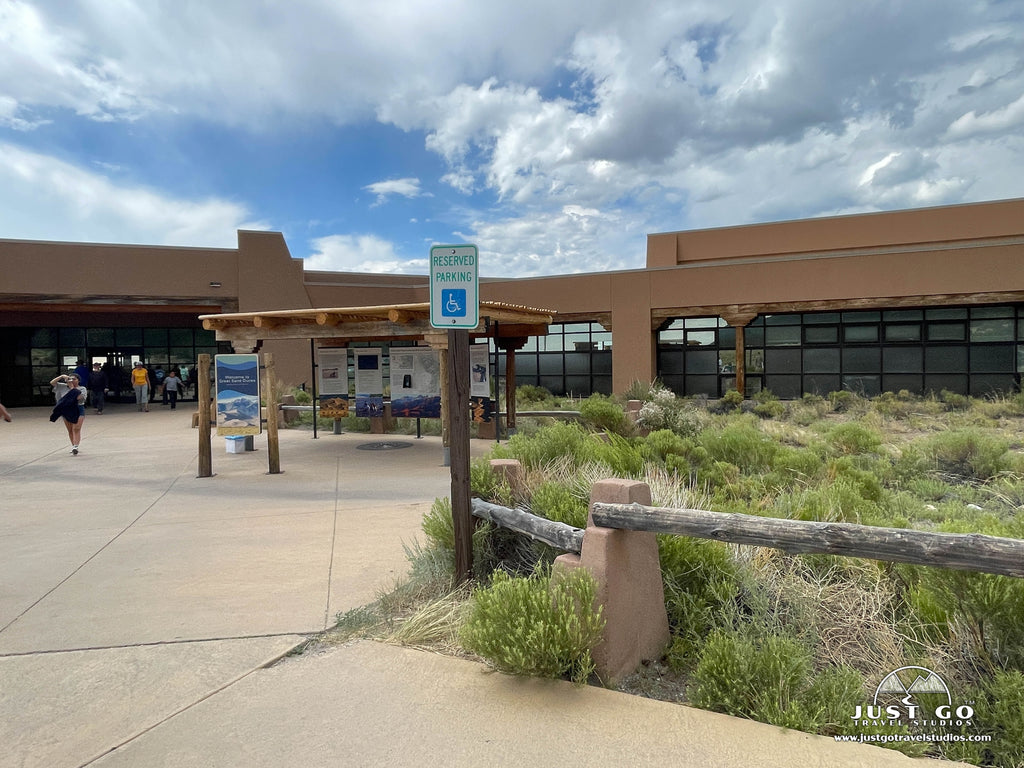
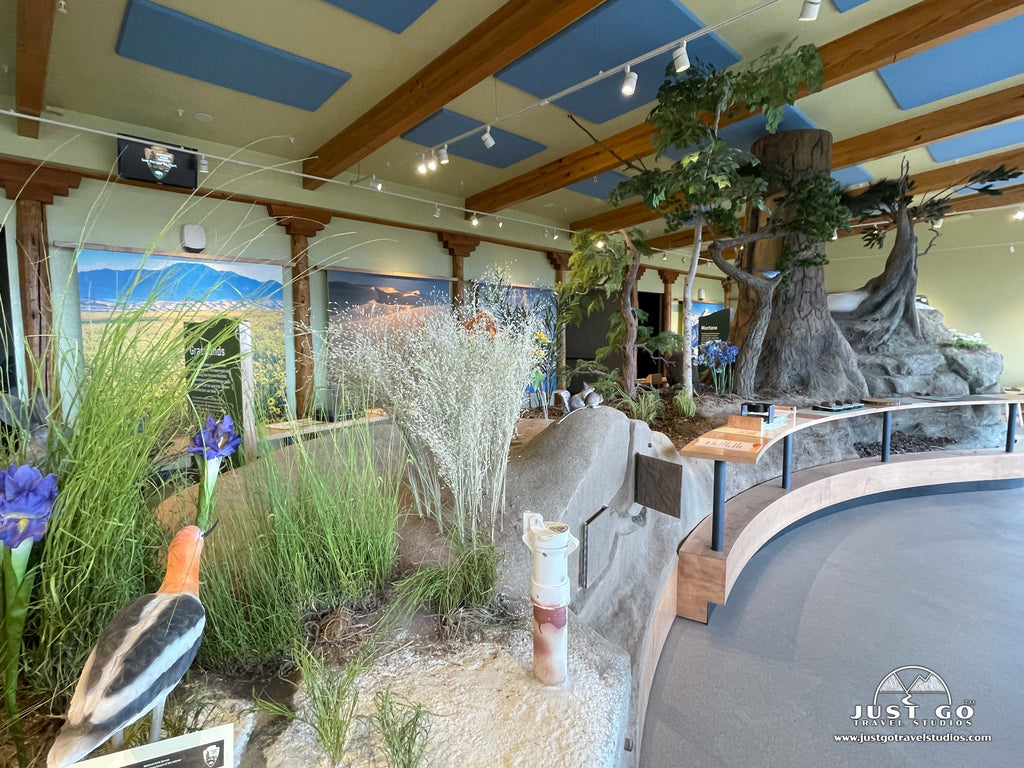
Exploring the Dunes
Get up close and personal with the park’s main attraction by walking on the dunes. From the Dunes Parking area, cross about a half-mile of the Medano Creek bed to reach the base of the dunes and then pick your path. There are no trails or markers. You can technically hike anywhere you wish within the 30 square mile dunefield. Know before you go: The shifting nature of the sand, steep inclines, and the park’s altitude (about 8,000’) make hiking the dunes more challenging than you might think. Take it slow and bring plenty of water. During summer months, plan to hike the dunes in the early morning or evening since sand surface temperatures may reach a scorching 150 degrees! Expect to have sand EVERYWHERE—in your hair, ears, clothing, and shoes. It’s inevitable if you plan to explore the dunes!
Three dunes locations to visit include:
- High Dune on First Ridge (hard, 4-miles (round-trip), 693 ft. elevation gain)). This trail is the easier of the two dunes.
- Star Dune (hard, 6.5 to 8 miles (round-trip), 741 ft. elevation gain)). This trail is the easier of the two dunes.
- Hidden Dune (hard, 4-miles (round-trip), 740 ft. elevation gain)). This trail requires you to go to the Castle Creek Picnic Area (via 4WD) and is one of the hardest hikes to do. The trail is unmarked.
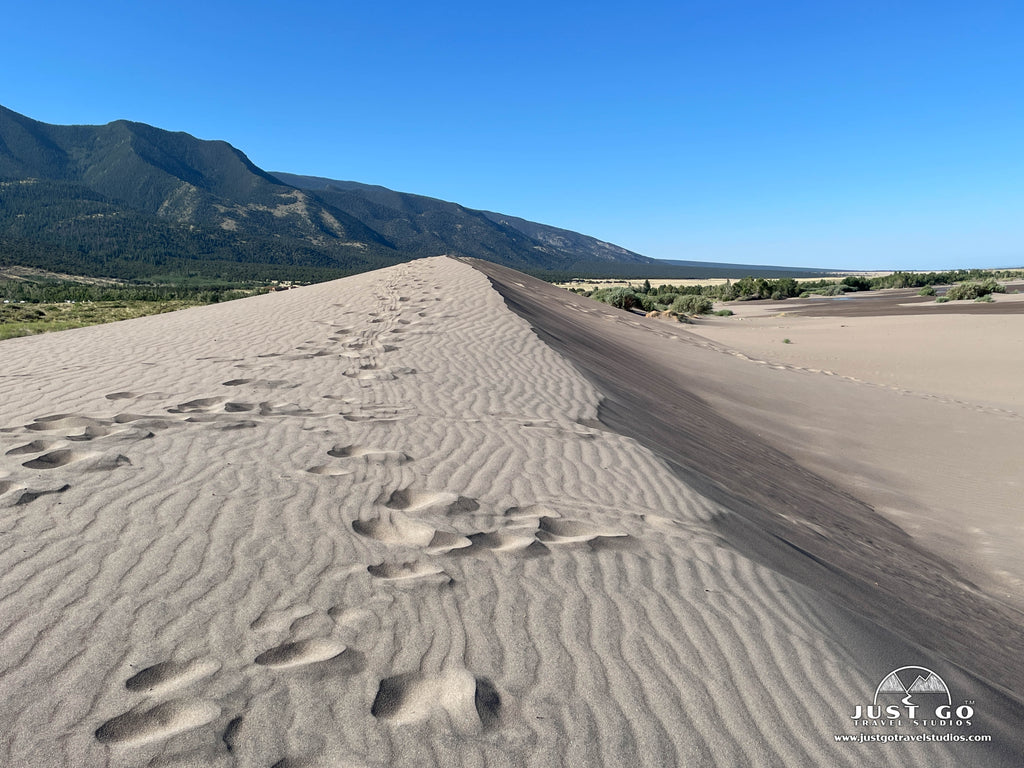

Sandboarding/Sand sledding
For a unique national park activity with amazing views try boarding or sledding down the dunes! The National Park Service does not rent sandboards or sand sleds; so, plan to rent gear before arriving in the park. From the main Dunes Parking Area, visitors will have to walk over half a mile to reach the base of the dunes. Then, choose your own adventure! Sandboarding and sledding are allowed anywhere on the dunefield away from vegetation. Start small and get the hang of the sandboard before heading for bigger hills.
The closest place to rent sandboards and sand sleds is the Oasis Store (open spring through early fall), located 4 miles from the visitor center. See the NPS page for more information on sand sledding and sandboarding at Great Sand Dunes, plus other retailers that rent gear in the San Luis Valley.
Splash in Medano Creek (seasonal)
If you visit Great Sand Dunes in late spring or early summer, you may get to enjoy a splash in Medano Creek. During an average year, Medano Creek arrives at the Dunes Parking Area by the end of April. Flow increases through May and typically peaks towards the end of May or beginning of June. The rate of flow varies widely from year to year depending on the snowpack above the dunes. It’s best to avoid May and June weekends since the peak flow of Medano Creek also brings large crowds and traffic at the park entrance station.

Stargazing
In 2019, Great Sand Dunes became certified as an International Dark Sky Park. Due to its remote location and minimal light pollution, Great Sand Dunes is the perfect destination for those who love stargazing and night photography. Check a moon calendar before your visit since a moonless night is best for viewing stars.
Hiking
The dunes may be the main attraction, but there’s more to this park than just sand! You will find a handful of marked trails along the park’s main road which lead through forests and grasslands that surround the dunes. (A 4WD vehicle is required to reach more challenging hikes which exist in remote mountainous areas of the park.)
In the Main Use Area of Great Sand Dunes, we recommend the following hikes:
- Mosca Pass Trail (moderate / hard, 6.2 miles, 1407 ft. elevation gain)). This trail heads up from the valley until it reaches Mosca Pass.
- Dunes Overlook Trail (moderate, 2.7 miles, 478 ft. elevation gain)). This heads to a small overlook of the dunefield and surrounding mountains.
- Montville Nature Trail (easy, 0.5 miles, 90 ft. elevation gain)). This easy hike has a bit of shade before getting to amazing views of the dunes.
- Wellington Ditch Trail (easy, 2.3 miles, 150 ft. elevation gain)). This hike gives great views of the dunes and is usually quiet. There is no shade.
- Sand Sheet Loop Interpretive Trail (easy, 0.25 miles, minimal elevation gain)). This starts from the visitor center and passes through the grasslands near the dunefield.
See the NPS website for more information on hiking at Great Sand Dunes.
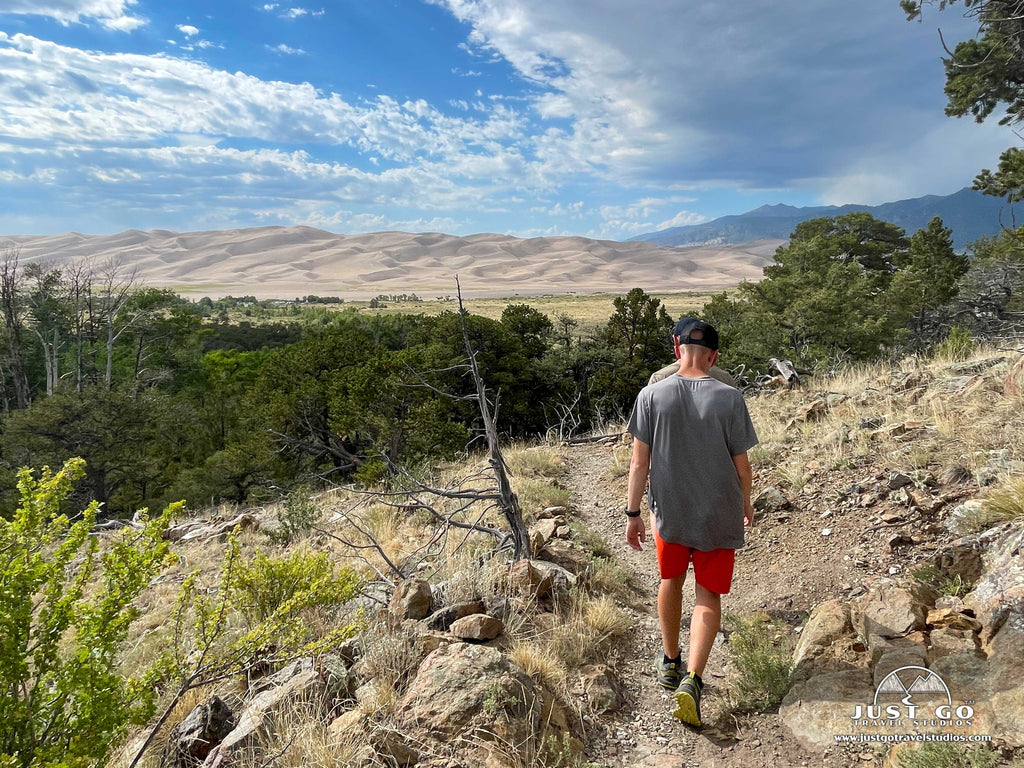

EXPLORING BEYOND THE MAIN USE AREA
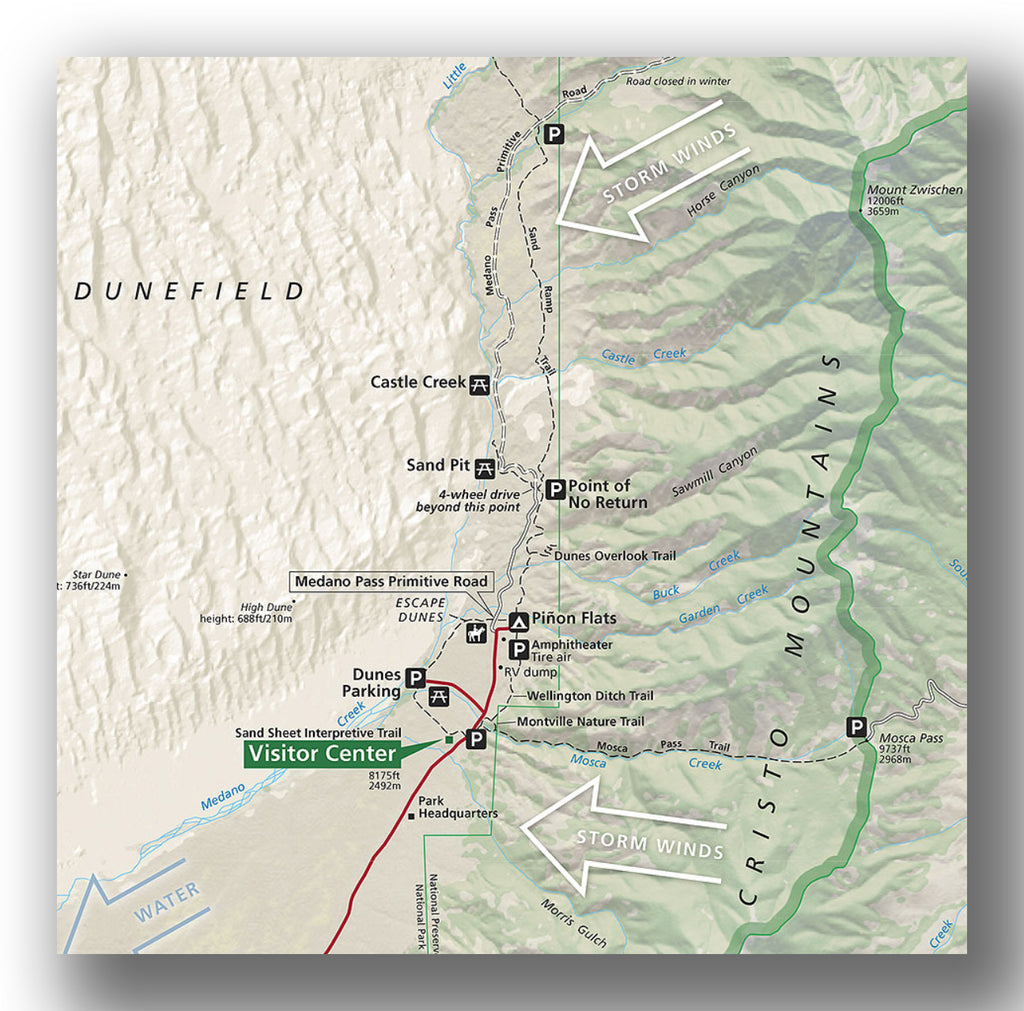
For adventurous park visitors with high clearance 4WD vehicles, these are some activities beyond the Main Use Area of Great Sand Dunes:
Medano Pass Primitive Road
Just beyond the Piñon Flats Campground, there is a rugged road that provides access to some stunning scenery in the Great Sand Dunes backcountry, plus some secluded campsites! Medano Pass Primitive Road is a rough, 22-mile drive that leads to Medano Pass at 10,040’. A high clearance 4WD vehicle is required due to multiple creek crossings, deep sand, large rocks, and uneven terrain (2WD drive vehicles, ATVs and OHVs are not permitted).
The 22-mile drive up to Medano Pass is estimated to take 1-1 ½ hours, depending on stops and road conditions (allow about 3 hours for an out-and-back trip). The road typically opens for the summer season around mid-late May and closes late November (if conditions allow). During dry times, vehicles should reduce tire pressure to about 20 psi to make it through deep, soft sand. If you air down your tires, a free tire pressure station is available at the Amphitheater for refilling them upon your return. See the NPS page for current road conditions on Medano Pass Primitive Road before heading out on your trip.


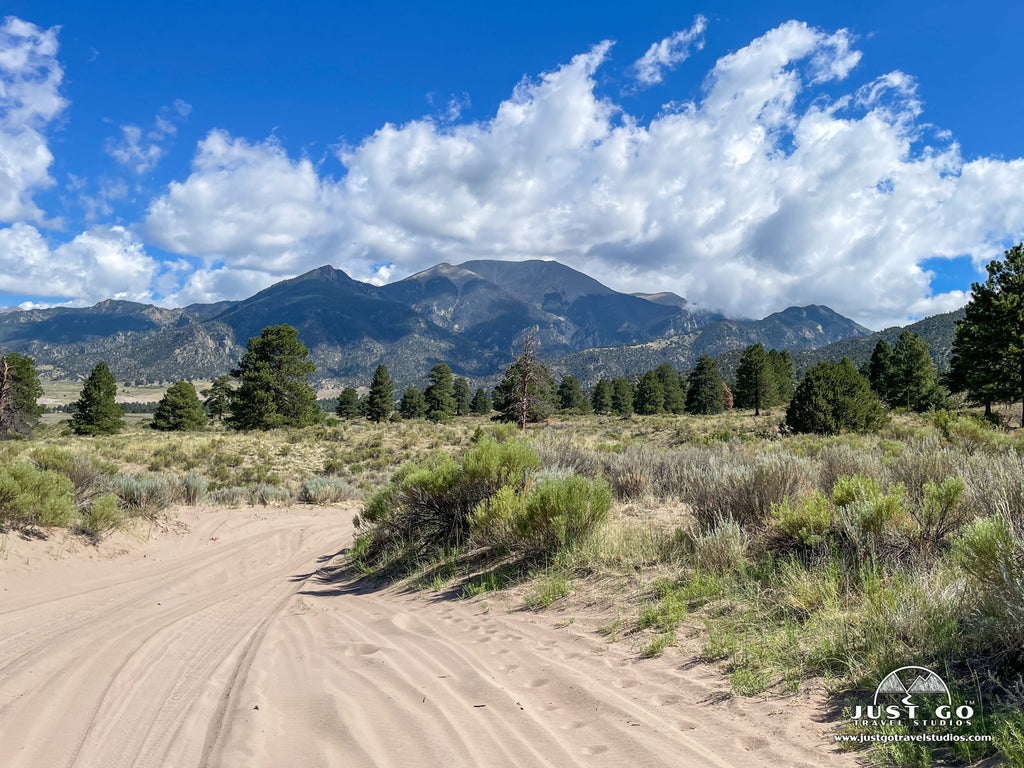
4WD Access to Hiking Trails in the Mountains
Most people never get to explore beyond the main use area of Great Sand Dunes and are surprised to hear that alpine lakes and summits are also a part of the park. If you have a high clearance 4WD, you can access hiking trails that lead to alpine paradises like Medano Lake or Upper and Lower Sand Creek Lakes.
- Medano Lake Trail (hard, 8.3 miles, 2340 ft. elevation gain)). This trail heads to a beautiful lake but is quite challenging.
- Upper and Lower Sand Creek Lakes (hard, 8 miles, 2000 ft. elevation gain)). This trail has it all! It goes through the forest and alpine tundra to reach a couple of lakes!
Zapata Falls Trail
Located just south of the park and on Bureau of Land Management land, a half-mile hike leads to a 30-foot cascading waterfall. From the trailhead, follow a rocky trail uphill until reaching the creek. To view Zapata Falls, you’ll have to travel up the stream a short way—through the water and over some slippery rocks. It is best to wear waterproof boots or shoes you can get wet since walking in the creek is required to see the waterfall at the end of the canyon. Although the creek and waterfall can be a refreshing way to escape the heat and hot sand at the park, expect the parking area and trail to be especially busy on hot, summer days.
To get to Zapata Falls, drive 8 miles southwest from the visitor center on Route 150 and turn left onto a rough dirt road marked by the Zapata Falls Recreation Area sign. Drive 3.5 miles to the parking area for the falls

HOW TO GET TO GREAT SAND DUNES NATIONAL PARK AND OTHER TRAVEL INFORMATION
Great Sand Dunes National Park is in south-central Colorado. The largest city near Colorado National Monument is Alamosa. There are no public transportation services for getting to or around the monument, so you’ll need to have your own transportation.
- If flying into Denver International Airport, here are directions from Denver to Great Sand Dunes National Park and Preserve. The 250-mile drive will take about 3 ½ hours.
- If flying into Colorado Springs Airport, here are directions from Colorado Springs to Great Sand Dunes National Park and Preserve. The 165-mile drive will take about 2 ½ hours.
- Here are some approximate travel distances/times if driving from other Colorado destinations:
- Mesa Verde National Park: 3 ¾ hours; 200 miles
- Black Canyon of the Gunnison National Park: 3 ½ hours; 190 miles
- Rocky Mountain National Park: 4 ½ hours; 250 miles
ENTRANCE FEES AND REQUIRED PASSES FOR GREAT SAND DUNES NATIONAL PARK
Yes, an entrance fee is required to enter Great Sand Dunes National Park and Preserve. The cost is $25 per passenger vehicle and the pass is valid for 7 days. However, if you plan to visit several national park sites this year, consider purchasing an Interagency Pass (America the Beautiful Pass) for $80.
WHERE TO STAY IN GREAT SAND DUNES NATIONAL PARK
Great Sand Dunes National Park Lodging: There are no lodging options inside Great Sand Dunes National Park and Preserve. There are a couple options just outside the park boundary (Great Sand Dunes Lodge and Great Sand Dunes Oasis); however, most visitors seeking hotel accommodations and dining options stay in Alamosa (about 35 miles from the park). Other lodging options are further away in Monte Vista and Del Norte.
Great Sand Dunes National Park Camping: Camping is the only way to spend the night inside the park and preserve. Piñon Flats Campground is the only front country campground in the park and has sites available from April through October. It is the only established campground within the park, and we can’t imagine staying anywhere else. The views from some of the sites are unbelievable! Plus, there are trails from the campground leading right to the dunes.
You can read about staying in the campground in our article on Camping in Great Sand Dunes National Park, which also covers camping outside of the park, as well as the primitive camping along Medano Pass Primitive Road.
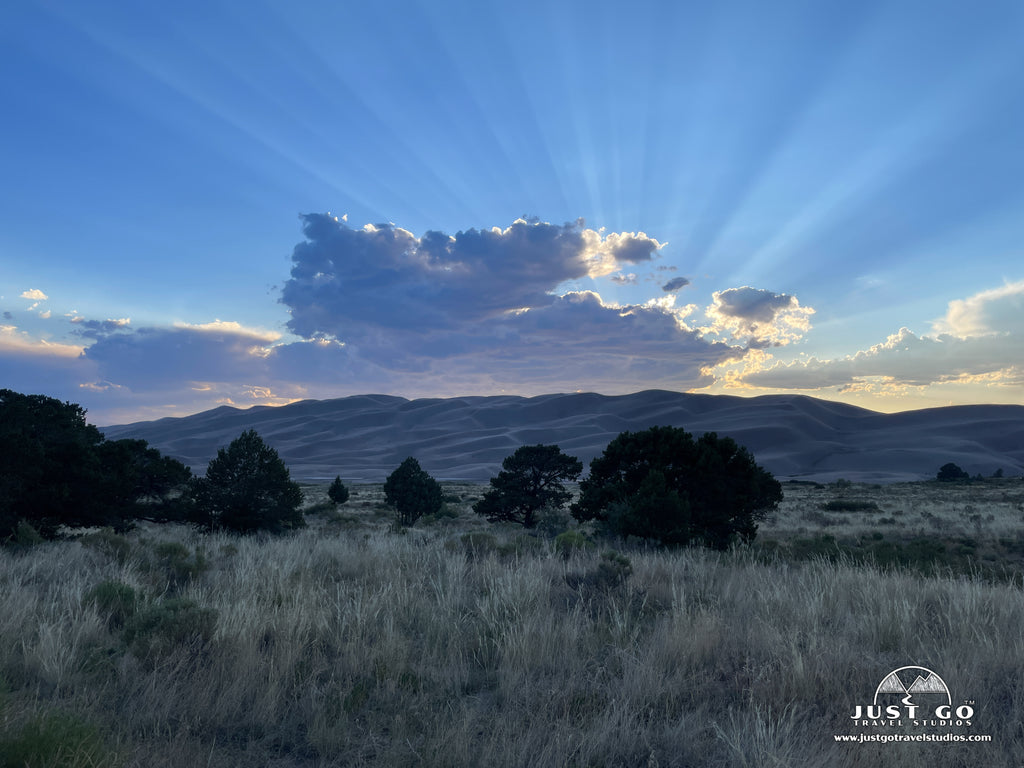
Backpacking. Backpacking is also an option, and you can visit our blog on the Hiking in Great Sand Dunes National Park to learn more.
WHEN IS THE BEST TIME TO VISIT GREAT SAND DUNES NATIONAL PARK?
Great Sand Dunes NP & P is open year-round, and each season offers a unique experience! If you enjoy hiking and exploring, the best times to visit Great Sand Dunes are late spring and early fall when temperatures are mild.
Late May to early June is typically the peak flow of the Medano Creek, so weekends during late spring tend to be extremely crowded. If you plan to explore Great Sand Dunes NP & P in late spring, be sure to plan your visit for a weekday. Spring can bring high winds and wild swings in temperatures (20°F to 60°F) so be prepared for any conditions (with warm layers and rain gear) and check the weather before your visit.
With warm weather and long days, summer is another busy season in the park. However, even on moderately warm, sunny days, sand surface temperatures can soar to 150°F! Plan to explore the dunes in the early morning or evening and head to mountain areas of the park (and surrounding areas) during summer afternoons. Afternoon thunderstorms are common during warmer months (especially July and August) so be prepared to leave the dunes immediately if you see approaching storms or any lightning.
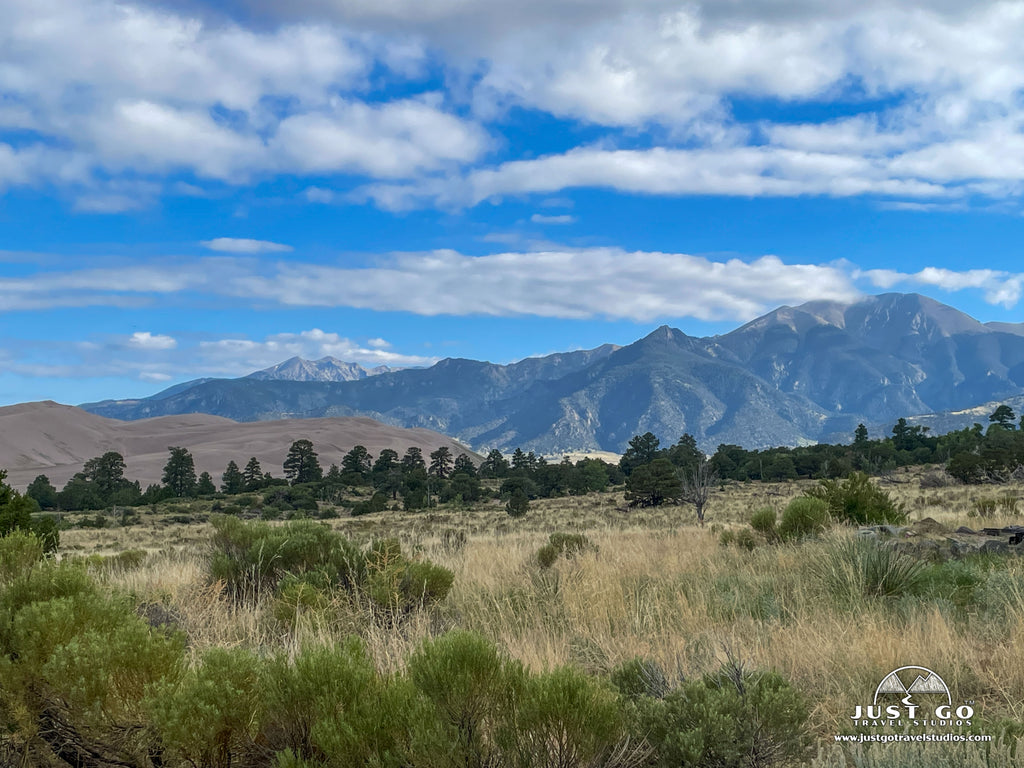
Fall is a great time to visit the park with generally pleasant temperatures and fewer crowds. With cooler daytime temperatures, fall is the perfect season to hike in the dunes. If you get lucky and visit during peak foliage, you can also witness the aspen trees turning golden yellow in the surrounding mountains.
Although winter brings cold temperatures and some snow, sunshine is generally abundant. Winter can be a magical time to visit the park with snow-covered dunes. Plus, the park doesn’t see many visitors during the colder months, so you may just end up having the park all to yourself! Just be sure to check the forecast before visiting and pack warm layers and sturdy footwear. Winter Visitation Pro: sand can be partially frozen in the winter and firm sand makes for easier hiking in the dunes. Winter Visitation Con: local shops will not rent sandboards when the sand is frozen.
WHAT TO BRING TO GREAT SAND DUNES NATIONAL PARK
Bring everything you need to enjoy a day at Great Sand Dunes. The park is remote and has limited services.
- Snacks/lunch and water. Bring a cooler with all the food and drinks you’ll need for the day. There is only a single restaurant within 25 miles of the park.
- Sun protection. There is little shade in the park and reflection off the sand can be intense. We recommend bringing sunscreen, a hat, and sunglasses.
- Hiking boots or sneakers. Sandals seem like the logical choice for a park with so much sand. However, during warm summer months, sand temperatures can reach up to 150 degrees! Wear closed-toe shoes or hike during morning or evening hours when the sand is cooler.
- After sandboarding or exploring in the dunes, you’ll likely have sand everywhere! There are outdoor rinse showers available at the Dunes Parking lot in summer months. There is no privacy, but you may want to at least rinse the sand off your arms, legs, and feet. A towel is handy to dry off afterwards and brush away any remaining sand.
IS THERE CELLULAR SERVICE IN GREAT SAND DUNES NATIONAL PARK?
No, due to the park’s remote location, there is limited connectivity to mobile phone service while visiting Great Sand Dunes. WiFi is not available in or near Great Sand Dunes NP & P. Visitors with Verizon service may find a signal in main use areas of the park (visitor center, campground and main dunefield).
ARE PETS ALLOWED IN GREAT SAND DUNES NATIONAL PARK?
Yes! Great Sand Dunes National Park and Preserve is one of only a few national parks that allows leashed pets in the main day use areas—including Piñon Flats Campground, Dunes Overlook Trail and along Medano Pass Primitive Road. They are allowed in the main day use area of the dunes but cannot travel in the backcountry of the dunefield (beyond the first high ridge of dunes) or to any backpacking campsites located inside the national park.
For your pet to have a safe and positive experience while visiting the park, keep your pet leashed at all times. If you plan to bring a pet to the park in the summer, be aware of extreme sand surface temperatures. Protect your pet’s feet with booties and plan to hike early in the morning or in the evening. Do not leave pets unattended in your vehicle or on your campsite.
RELATED INFORMATION ON GREAT SAND DUNES NATIONAL PARK FROM JUST GO TRAVEL STUDIOS
- Before your trip, be sure to download a copy of our itinerary for Great Sand Dunes National Park!
- When you are in the area, be sure to consider going to other Colorado parks, like Colorado National Monument and Black Canyon of the Gunnison National Park!
- Once you return from your trip, contact us and we’ll work with you to create a custom, vintage travel poster. We look forward to working with you!
